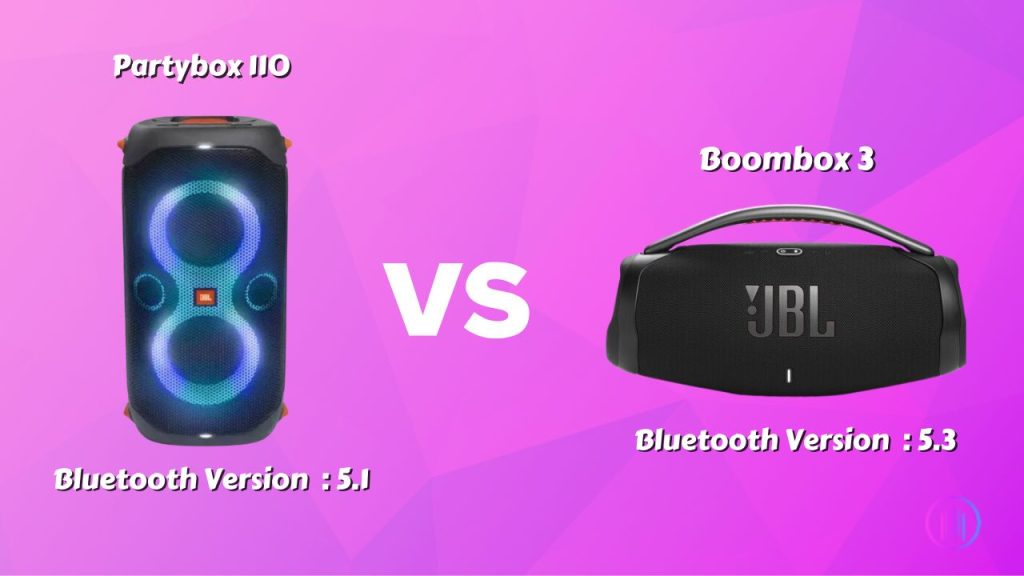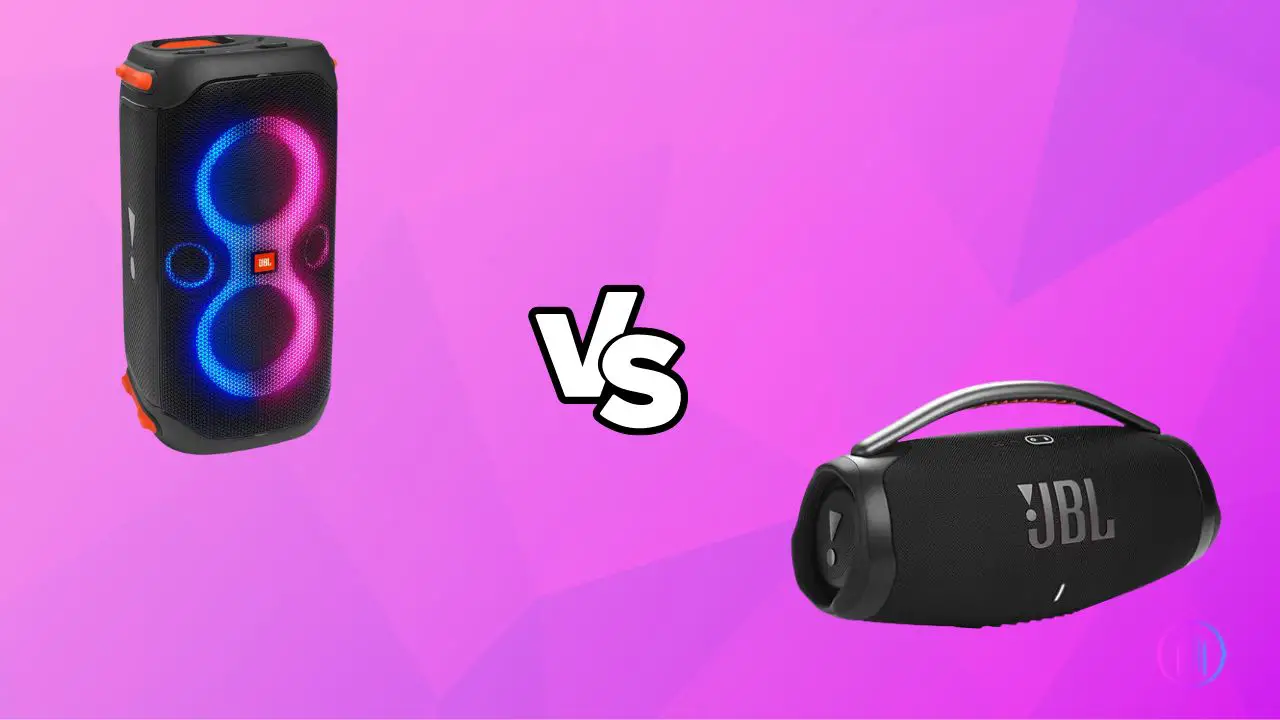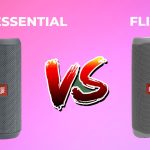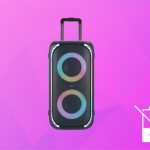JBL is a quality audio products manufacturer with two renowned speakers, i.e., Partybox 110 Vs. Boombox 3. Both speakers have amazing features and audio quality; however, you may want to find out which one’s better. Here’s a detailed review of both speakers’ features and audio quality.
Let’s get started!
Quick Answer: In my opinion, the Partybox 110 is a better option than the Boombox 3 because of its rigid design, extra guitar, mic inputs, audio jack, and long battery life of 12 hours. It has a better frequency range, which helps deliver better bass, mids, and trebles. Finally, this speaker has an IPX4 rating, which I tested and found to be completely rain and splash-resistant, making it suitable for outdoor use.
Overall Comparison: Partybox 110 Vs Boombox 3
| Feature | Boombox 3 | Partybox 110 |
|---|---|---|
| Weight | 6.74 kg | 10.84 kg |
| Power Output | 180 Watts | 160 Watts |
| Frequency Response | 40 Hz- 20 KHz | 45 Hz- 20KHz |
| Bluetooth | 5.3 | 5.1 |
| Wifi | No | No |
| AUX input | No | Yes |
| Guitar input | No | Yes |
| Mic input | No | Yes |
| Battery Life | 24 hours | 12 hours |
| Charging Time | 6.5 hours | 3.5 hours |
| Dust Resistance | IP67 | No |
| Water Resistance | IP67 | IPX4 |
| USB | Type-C | Type-A |
| Companion App | JBL Portable App | JBL Partybox |
| Equalizer | Yes | Yes |
| Partyboost | Yes | No |
Detailed Comparison: Partybox 110 Vs. Boombox 3
Design, Rigidity, and Portability
The First few things to consider when comparing the two speakers are the design and build quality. JBL speakers are known for their rugged design and durability, which is the case with these two speakers.
JBL Partybox 110 has a rugged build and weighs about 10.84 kg. It has an LED light, which adds great value to the overall design of the speaker. In addition, this speaker has an IPX4 rating, which means it’s rain and splash-resistant.

On the other hand, the Boombox 3 is a more portable option, with a silicone build and weight of only 6.74 kg. This speaker doesn’t have LED lights like its competitor; however, it has an IP67 rating, which means it’s completely dust and water-resistant.
I tested the durability of both speakers by throwing them in the car trunk with other materials and found that the Partybox 110 does get a few scratches on the body. Still, the Boombox 3 remains safe and unharmed because of its mesh fabric body.
In addition, I tested both speakers’ dust and water endurance by playing them in rain and under water splashes. Both the speakers endured the rain and splashes of water without any damage.

Since the Boombox 3 has an IP67 rating for dust and water resistance, it is submersible in water for 30 minutes and completely dustproof. I tried playing audio on this speaker by submerging it in water and a dusty area, and the speaker functioned perfectly without any damage.
So, Boombox 3 is a better option regarding design, rigidity, and portability.
Battery Life:

Now, let’s talk about the battery life of both speakers. JBL Partybox 110 has an advertised battery life of 12 hours with a charging time of 3.5 hours, and Boombox 3 has an advertised battery life of 24 hours with a charging time of 6.5 hours.
I tested both speakers’ battery life individually and found that the Partybox 110 has 12 12-hour battery life if the music is played a little above 20%, the light feature is turned off, and the mega bass is turned on. Whereas, with its light feature turned on, bass boost set to deep, and 65% volume, the speaker’s battery life was 8 hours.
However, in a similar test, the Boombox 3 had a battery life of 24 hours with music playing at 50% volume, which is a pretty decent volume and much better than the Partybox 110 playing at 20 or 30% volume.
Finally, both these speakers have a built-in power bank, which allows the user to charge their devices from the speaker in case of emergency.
So, in terms of battery life, the Boombox 3 is a better option.
Bluetooth and Other Connections:

Both Partybox 110 and Boombox 3 are Bluetooth speakers; however, Boombox 3 features Bluetooth 5.3, an advanced version of Bluetooth, compared to Partybox 110, which features Bluetooth 5.1. Both devices can connect to up to 2 devices simultaneously, but Boombox 3 has a better connectivity range, lag-free audio transmission, and faster connectivity.
I checked the connectivity range of both speakers by moving the audio source away from the speakers and observed that both speakers could deliver lag-free audio up to 32 feet.
Furthermore, these speakers also offer a wired connection, i.e., an AUX input to connect the speakers to devices that do not have wireless connectivity options. However, there’s one connectivity option that Partybox 11o has above Boombox 3, i.e., Microphone and guitar input. These two inputs make Partybox 110 a great choice for karaoke parties.
Audio Signature and Quality:
Now, let’s talk about the audio quality of the two speakers. Partybox 110 has a dual upward-firing subwoofer and tweeters, whereas the Boombox 3 has a dual upward-firing tweeter stacked on top of the woofers to complement the dual passive radiators that shoot out the sides.
I conducted a sound test of both speakers at 81% volume with Partybox 110 bass boost set to deep and Boombox 3 in its general EQ settings.
Both speakers have excellent audio performance; however, the Boombox 3 has a better and louder sound signature. There is much emphasis on mids and trebles in Boombox 3, and an adjustable Equalizer allows the user to tune the bass, mids, and trebles as desired. However, sometimes, the highs sounded too shrill at higher volumes, and the bass could use more value. The Boombox 3 has an additional feature that gives it an edge over the Partybox 110, i.e., the Partyboost feature. It allows the speaker to connect with a daisy chain of speakers for simultaneous playback.
On the other hand, the Partybox 110 has a more balanced audio signature in the similar sound test, with deep bass delivery and quite balanced mids and highs. It doesn’t have the Partyboost feature to daisy chain the speakers; however, it does come with the RCA jack which you can use to connect the speaker with another Partybox 110 to form a stereo pair.
However, I observed that Partybox 110 performs indoors better because of its balanced audio signature. JBL Boombox 3, on the contrary, is a great choice for outdoor settings because of its brighter audio signature.
So, according to my test results, Partybox 110 has better audio quality than the Boombox 3.
Usability
Beach, pool, and Outdoor parties.
Both speakers have great outdoor audio applications; however, I tested the speakers for their sturdiness and found the Boombox 3 more suitable because of its complete dust and water resistance. Furthermore, as tested earlier, Boombox 3 has a brighter audio signature and a Partyboost feature to daisy chain many compatible speakers, allowing a louder audio playback, which is best in outdoor settings.
Hiking and Road Trips
Boombox 3 is a more portable option for hiking and road trips. I tested and found it a better option than the Partybox 110 because of its less weight, smaller size, and more rigid build that protects it against rough and bumpy rides.
Furthermore, this speaker has an amazing battery life of 24 hours, which is ideal for long trips, with a built-in power bank to charge the phone batteries when in need.
Karaoke Party and Street Singing
Now, if you’re trying to arrange a Karaoke party or a street singer, the JBL Partybox 110 is a better option, as it comes with a mic and guitar input. Furthermore, with an IPX4 rating and 12-hour battery, you can do your street performance without worrying about rain or the battery dying in the middle of the performance.
Final Verdict
Overall, the Partybox 110 is a strong competitor and a better option because of its better sound quality, great battery life performance, and diverse connectivity options. However, the Boombox 3 has many vivid features like longer battery life, IP67 rating, and better durability. However, it still doesn’t get the edge because of its overly bright sound signature, emphasizing high-frequency notes, making it a bit harsh at higher volumes.
In the end, Partybox 110 is also a better option in terms of price, as it costs about 70-80$ less than Boombox3, making it an economical option.

I’m Shaun Conroy, an audiophile & founder of HiFi Audios. Holding a Bachelor’s in Sound Engineering, I bring deep expertise in audio devices and offer insights & recommendations to fellow enthusiasts.





